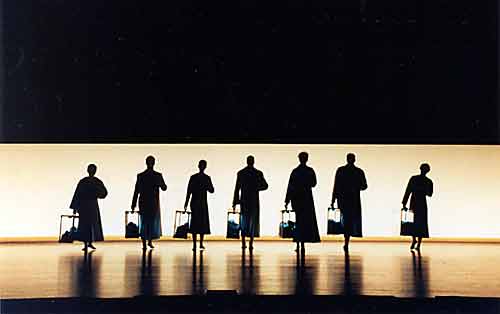|
|
|
| La Scena Musicale Online Reviews and News / Critiques et Nouvelles |
Visit La Scena Musicale Online Reviews. [Index] Critiques de La Scena Musicale Online
Kopernikus a Provocative Theatrical Experience
By Joseph So June 29, 2001 |  |
Kopernikus (Claude Vivier 1948-1983)
Autumn Leaf Performance
June 21, 2001
MacMillan Theatre, University of Toronto
Pascal Rophe, music director
Stanislas Nordey, stage director
Emmanuel Clolus, set designer
Axel Morgenthaler, lighting designer
Raoul Fernandez, costume designer
Photo Credits: Donald Lee/ The Banff Centre; Yves Renaud
Patricia O'Callaghan, soprano
Patricia Green, soprano
Isabel Soccoja, mezzo-soprano
Shaunaid Amette, alto
Michiel Schrey, tenor
Ian Funk, baritone
Simon Fournier, bass-baritone
 |
|
L to R: Ian Funk, Shaunaid Arnette, Michiel Shrey
|
It is sometimes argued that the best of contemporary works speak to us through the process of experience rather than necessarily through understanding. By this axiom, Claude Vivier's Kopernikus is an interesting example of this genre. And a dazzling theatrical experience it was, judging by the hugely enthusiastic response on opening night of a three-performance run at the MacMillan Theatre, University of Toronto. Members of the audience – unusually young for opera, I might add – who responded to my queries all felt that they had seen something extraordinary and were touched by it in some way, though many were hard-pressed to verbalize exactly what they witnessed. Perhaps more than anything, this atypical opera audience underscores the gulf between the old and the new. Unlike the more conservative, "mainstream" opera audiences with preferences for the old warhorses, this audience is not as hung up about literal meanings. Rather it is willing to live the experience. Kopernikus has spoken.
It has taken a year for this opera to make its way to Toronto, its final stop on a highly acclaimed international tour. It was well worth the wait. Vivier's only opera, it is a chamber work for seven voices and eight instrumentalists. There is little storyline to speak of, as the composer himself noted. The principal character, Agni, a child-like figure complete with teddy bear interacts –presumably in her dreams – with prominent figures in western cultural history – Lewis Carroll, Merlin, Queen of the Night, Mozart, Copernicus, Tristan und Isolde, etc. Through them, Agni reaches a deeper – cosmic if you will – understanding of her own existence.
One of Canada's more prolific composers in his all-too-brief life (he was murdered in Paris at the age of thirty-four), Vivier was a student of German composer Karl Stockhausen, whose influence can be detected in Kopernikus, as well as many other sources, including eastern musical sensibilities. Scored for an eclectic mix of instruments – one violin, four wind, two brass and percussion, it is not your conventional orchestra and Vivier's musical stamp is evident in the originality of the sounds coming from the pit. The use of voices – of which there were seven, is also highly individualistic, with the composer exploring song, sung speech in varying pitches and inflections, and nonsense sounds.
The challenges of the vocal writing and the stage direction are formidable. This production benefited from an ensemble of committed singing actors, headed by Shaunaid Amette as Agni. The voices are young and fresh, and suitable for the relatively small space such as the MacMillan Theatre. Pascal Rophe conducted the luminous score with transparency and delicacy, coaxing just the right sounds from the orchestra. Special kudos go to the lighting designer Axel Morgenthaler for the ingeniously lit, highly memorable images. Not to be forgotten is the sets by Emmanuel Clolus whose raised economy of means to a fine art.
The opening image, already made famous in all the publicity posters with the soloists silhouetted against a brilliantly lit backdrop, is stunning. What followed was a 70-minute work, with Agni staged front and center, while the various mythical characters sang and acted around her, revealing to her the secrets of their respective histories. A symbolic turning point of sorts came when the characters, including Agni, changed to the overcoats of (intergalactic?) travelers, leaving for places unknown. The final image echoed that of the opening, when the soloists exit the same way, carrying their old clothes in plexiglass suitcases reminiscent of ones carried by the gods to Valhalla in Harry Kupfer's Ring Cycle in Bayreuth a dozen years ago.
 |
|
End Scene
|
Commenting on the title of the opera, Vivier had this to say:
"I named my opera Kopernikus because the piece's namesake was the first to realize the
earth is not the center of the universe. By virtue of this discovery, he charted the destiny
of humanity; to strive continually for meaning in the endeavour to explore new horizons"
The central character of Agni is left deliberately vague and open to interpretation. Vivier seemed to take an extreme relativist position in his view of human existence and our place in nature. Arguably the relativistic and interpretive lens represent a refreshing step in the search for meaning, and it opens up whole new levels of understanding in a work like Kopernikus.
Visit La Scena Musicale Online Reviews. [Index] Critiques de La Scena Musicale Online
|
|
|

